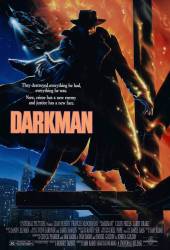Continuity mistake: When Peyton returns to his lab after its destruction, a burnt picture of him and Julie is on the floor. The destroyed picture shows half of Peyton's face missing. After finding a new place to stay, when the picture is put into the scanner, more of Peyton's face is visible. (00:28:10 - 00:30:40)

Darkman (1990)
Ending / spoiler
Directed by: Sam Raimi
Starring: Liam Neeson, Frances McDormand, Larry Drake, Colin Friels
Peyton (Liam Neeson) gets even and kills all those that were involved with the destruction of the lab and the death of his colleague. Julie (Frances McDormand) wants to be with him but he doesn't want to, fearing she won't love him because of his face.
Peyton Westlake
Trivia: During a scene in the movie, Darkman cries out "JULIE.". The voice of Darkman for this scene was not done by Liam Neeson, but was in fact done by Bruce Campbell. http://en.wikipedia.org/wiki/Darkman#Darkman_Trivia.
Question: When Peyton wakes up in the hospital, images suddenly appear. What exactly is the significance of the light bulb shattering and the little marionette with the huge head supposed to represent?
Join the mailing list
Separate from membership, this is to get updates about mistakes in recent releases. Addresses are not passed on to any third party, and are used solely for direct communication from this site. You can unsubscribe at any time.
Check out the mistake & trivia books, on Kindle and in paperback.




Answer: It's just psychedelic imagery to try and show his fragile state of mind and how he's losing it. The shattering light-bulb is likely to show that his mind is "shattering" (as light-bulbs appearing above someone's head are often used to signify brains/ideas in fictional, particularly cartoons), and the marionette "dancing" is the first part of the recurring motif in which he sees himself as a "freak." (Which is paid off later when he starts singing a demented song about "Paying five bucks to see the dancing freak!").